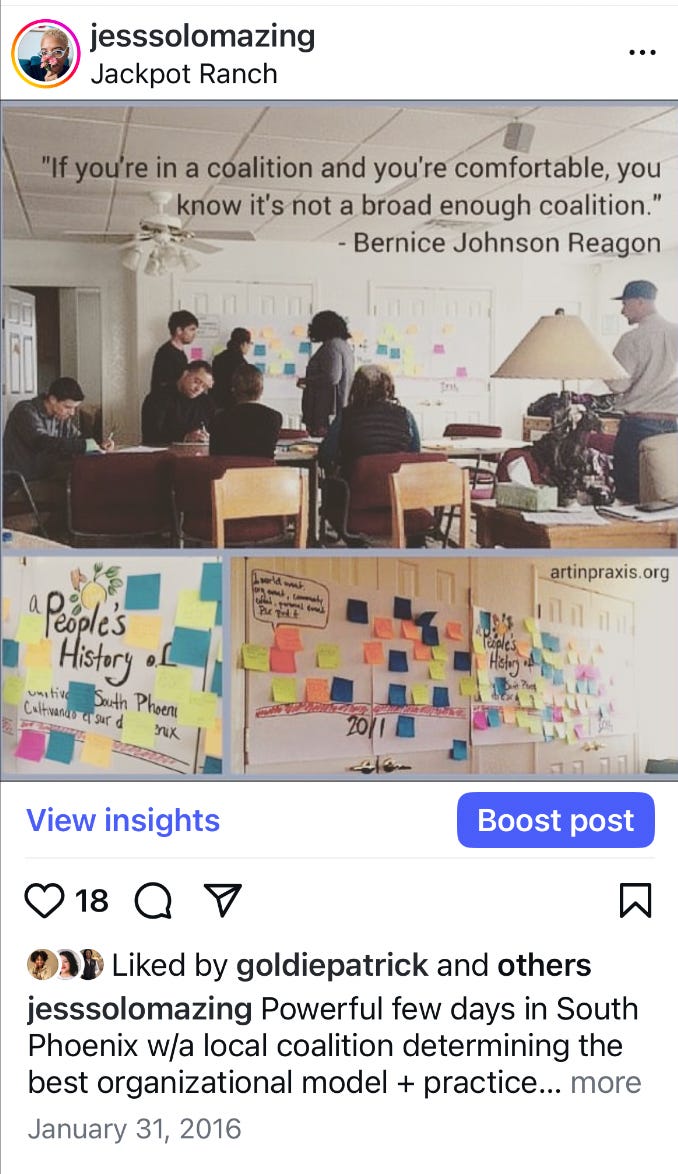In 2016, I was invited to facilitate an offsite retreat for a long-standing coalition in Phoenix at a crossroads.
Before making their next big decision, they needed to pause and reflect on their journey to date - not just the polished, funder-friendly version, but the real, layered, complicated one.
That’s when I created an activity and process called: A“People’s History of (Your Organization)” aka “People’s History.”
Since then, I’ve used “People’s History” with dozens of groups in social justice, arts and culture and philanthropy; a few pictured below. It’s become one of my most trusted and meaningful tools.
I’m drawing clearer connections between memory work, community archiving and organization development because the moment calls for it.
Why Memory Work Matters
Every group and organization has a story. Most just don’t make time to tell it and learn from it, internally.
The “People’s History of…” process and activity creates that space to pause, reflect, and remember.
When we lose organizational memory, we lose lessons hard-earned, relationships built, and context that shapes our purpose. That loss shows up in the work - through recreating what already exists, repeated mistakes, fractured trust, and missed opportunities.

Activity and Process
What we do:
We start with building a collective timeline of the organization’s history and milestones.
Then we weave in personal stories and anecdotes, sociopolitical/cultural/climate/technological events.
Finally we make meaning of the history/timeline together. We tell stories and make connections across time.
Why? Because the work didn’t happen in a bubble. It likely happened during climate disasters, political shifts, public health crises, and organizational and personal transitions.
What it Reveals
That full picture matters. Naming the systems and conditions you were responding to, resisting, or creating provides context for future planning. The history/timeline is living, and everyone in the room regardless of role or tenure has contributions that matter.
We look for:
Patterns – What themes repeat? What values show up during challenges?
Outliers – What moments broke the mold?
Grief + Joy – What personal or collective emotions show up beside the work?
“People’s History of…” connects emotional truth to organizational learning. In my experience, many participants see this activity as the first time they’ve been invited to bring their full self into organization development activities.
That shift alone can change everything.
Concrete Example: People’s History of Public Welfare Foundation (PWF)
During a staff offsite retreat, PWF staff (pictured above) collaboratively built a timeline of the orgs milestones from 2018 to 2023. They mapped key institutional achievements—like launching transformative justice initiatives and deep community investments—alongside personal stories and major societal events.
The process and activity highlighted PWF’s core values such as racial equity, economic well-being, and restorative justice. In the reflection, staff emphasized how specific timeline events resonated deeply and reinforced PWF’s community-centered strategy. The activity and process strengthened alignment and clarified future strategic directions.
What ‘s Happens After “People’s History of…”?
Things groups have done with their histories:
Translated the timeline into insights in a clear, visual summary.
Shared their story widely.
Hosted a follow-up session to dig deeper together. They named what still felt tender, what needed more context, and what’s was calling for repair and celebration.
Informed future planning, culture shifts, and decision-making.
Integrated into onboarding. New hires got context. The timeline became a way to welcome new staff into the story they’re now part of by adding their stories.
Ready to Try “People’s History of…” With Your Organization or Team?
Yay! You want to move forward with more clarity and care, and that can start by remembering and understanding where you’ve been.
You don’t have to do it alone. I offer:
Facilitation of the “People’s History of…” process and activity
Coaching for leaders who want to facilitate it themselves
Workshops to incorporate timeline data into storytelling, planning, decision making and culture change work
This process is especially useful for:
Organizations in transition
Teams navigating change, loss, or uncertainty
Groups seeking alignment and connection




